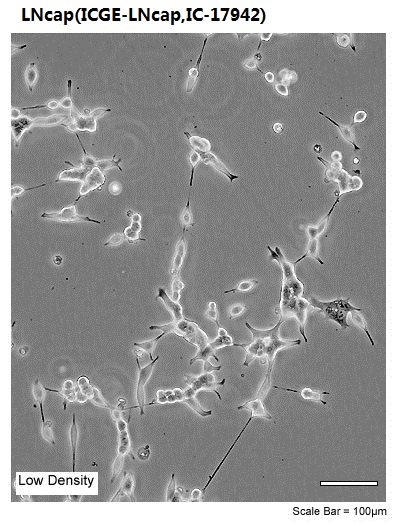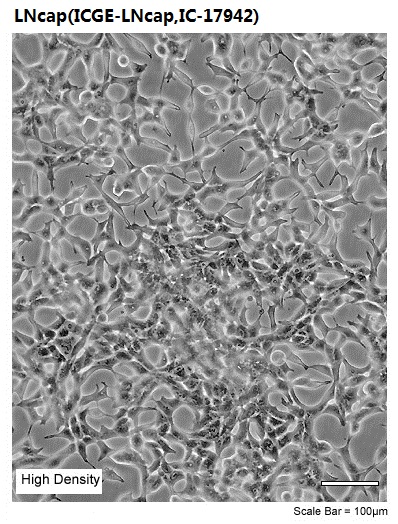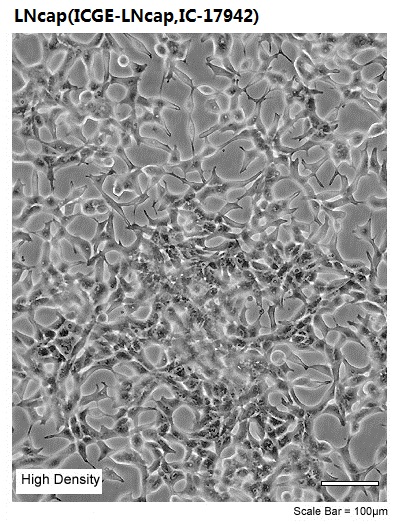


Overview
| Organism | Homo sapiens, human |
|---|---|
| Tissue | prostate; derived from metastatic site: left supraclavicular lymph node |
| Product Format | frozen |
| Morphology | epithelial |
| Culture Properties | adherent, single cells and loosely attached clusters |
| Biosafety Level |
1
Biosafety classification is based on U.S. Public Health Service Guidelines, it is the responsibility of the customer to ensure that their facilities comply with biosafety regulations for their own country. |
| Disease | carcinoma |
| Age | 50 years adult |
| Gender | male |
| Ethnicity | Caucasian |
| Applications |
This cell line is suitable as a transfection host.
|
| Storage Conditions | liquid nitrogen vapor phase |
Properties
| Karyotype | This is a hypotetraploid human cell line. The modal chromosome number was 84, occurring in 22% of cells. However, cells with chromosome counts of 86 (20%) and 87 (18%) also occurred at high frequencies. The rate of cells with higher ploidies was 6.0%. |
|---|---|
|
|
|
| Derivation |
LNCaP clone FGC was isolated in 1977 by J.S. Horoszewicz, et al., from a needle aspiration biopsy of the left supraclavicular lymph node of a 50-year-old Caucasian male (blood type B+) with confirmed diagnosis of metastatic prostate carcinoma.
|
| Clinical Data |
50 years adult
from a needle aspiration biopsy of the left supraclavicular lymph node of a 50-year-old Caucasian male (blood type B+) with confirmed diagnosis of metastatic prostate carcinoma.
Caucasian
male
|
| Receptor Expression |
androgen receptor, positive; estrogen receptor, positive
|
| Genes Expressed |
human prostatic acid phosphatase; prostate specific antigen
|
| Cellular Products |
human prostatic acid phosphatase; prostate specific antigen
|
| Tumorigenic | Yes |
| Effects |
Yes, in soft agar
Yes, the cells are tumorigenic in nude mice
|
| Comments |
These cells are responsive to 5-alpha-dihydrotestosterone (growth modulation and acid phosphatase production).
The cells do not produce a uniform monolayer, but grow in clusters which should be broken apart by repeated pipetting when subcultures are prepared.
They attach only lightly to the substrate, do not become confluent and rapidly acidify the medium.
Growth is very slow.
The cells should be allowed to incubate undisturbed for the first 48 hours after subculture.
When flask cultures are shipped, the majority of the cells become detached from the flask and float in the medium. Upon receipt, incubate the flask (in the usual position for monolayer cultures) for 24 to 48 hours to allow the cells to re-attach. The medium can then be removed and replaced with fresh medium.
If desired, the contents of the flask can be collected, centrifuged at 300 X g for 15 minutes, resuspended in 10 mL of medium and dispensed into a single flask.
|
Background
| Complete Growth Medium |
The base medium for this cell line is ATCC-formulated RPMI-1640 Medium, ATCC 30-2001. To make the complete growth medium, add the following components to the base medium: fetal bovine serum (ATCC 30-2020) to a final concentration of 10%. |
|---|---|
| Subculturing |
Volumes are given for a 75 cm2 flask. Increase or decrease the amount of dissociation medium needed proportionally for culture vessels of other sizes. Corning® T-75 flasks (catalog #430641) are recommended for subculturing this product
Subcultivation Ratio: A subcultivation ratio of 1:3 to 1:6 is recommended
Medium Renewal: Twice per week
|
| Cryopreservation |
Freeze medium: Complete growth medium supplemented with 5% (v/v) DMSO
Storage temperature: liquid nitrogen vapor phase
|
| Culture Conditions |
Atmosphere: air, 95%; carbon dioxide (CO2), 5%
Temperature: 37��C
|


